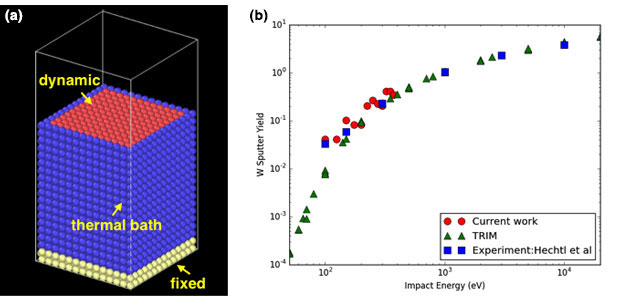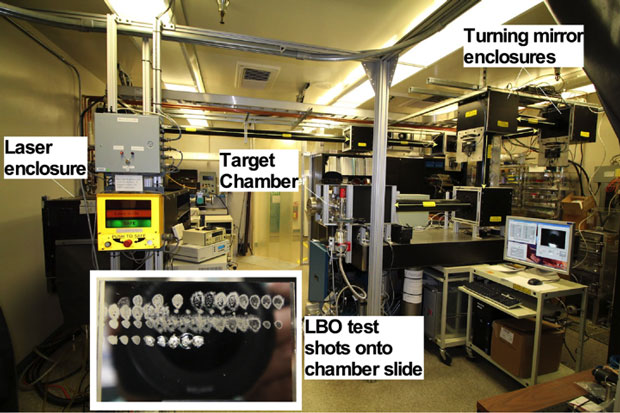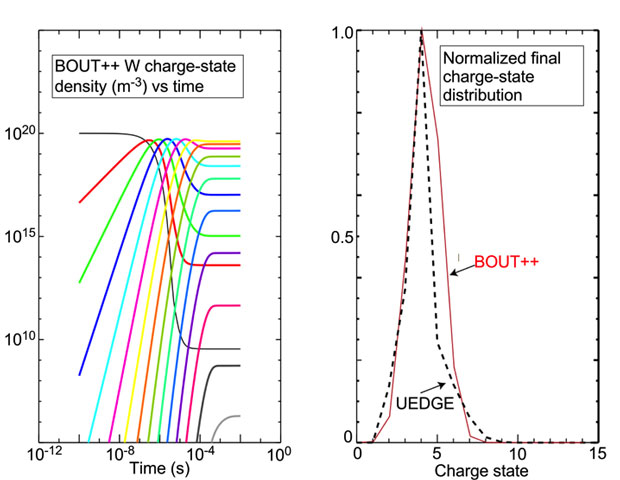Thomas Rognlien (14-ERD-101)
Abstract
Our project combined three discipline areas at Lawrence Livermore to develop an advanced capability to predict the impact of plasma–material interactions on metallic surfaces in magnetic fusion energy devices. These areas are (1) modeling transport of wall impurity ions through the edge plasma to the core plasma, (2) construction of a laser blow-off system for injecting precise amounts of metallic atoms into a tokamak plasma, and (3) material science analysis of fundamental processes that modify metallic surfaces during plasma bombardment. The focus is on tungsten, which is being used for the ITER divertor in France, and in designs of future magnetic fusion energy devices. For the first area, we have worked with the University of California, San Diego, on applications of the UEDGE (plasma edge transport) and DUSTT (dust transport) coupled codes to predict the influx of impurity ions from tungsten dust through the edge plasma, including periodic edge-plasma oscillations, and revived a parallel version of UEDGE to speed up these simulations. In addition, the impurity transport model in the two-dimensional UEDGE code has been implemented into the three-dimensional BOUT++ turbulence and transport code to allow fundamental analysis of the impact of strong plasma turbulence on the impurity transport. For the second area, construction and testing of the laser blow-off injection system has been completed. The original plan to install the laser blow-off on the National Spherical Torus Experiment Upgrade (NSTX-U) at Princeton and its use to validate the impurity transport simulations was delayed because NSTX-U was offline for a substantial magnetic coil repair period. In the third area, an analytic model has been developed to explain the growth of tungsten tendrils (or fuzz) observed for helium-containing plasmas. Molecular dynamics calculations of tungsten sputtering by tungsten and deuterium ions show that a spatial blending of interatomic potentials is needed to describe the near-surface and deeper regions of the material.
Background and Research Objectives
Magnetic fusion energy devices must be designed to control the interaction between the hot fusing plasma and surrounding wall materials. Exhausting plasma sputters undesirable wall material, which is partially screened by the adjacent edge plasma region, thus reducing the amount that reaches the confinement region. For high-power operation, solid walls may reach melting limits, severely limiting or prohibiting operation. Predicting the behavior of such systems, especially when multiple wall materials are present, is a very challenging scientific problem. This project combines the expertise of Livermore's edge-plasma modeling and experimental diagnostics with material modeling to provide an ongoing capability to validate simulation plasma and material interaction models of plasma-induced changes to materials in magnetic fusion energy devices. A set of specific issues is addressed for tungsten, which will be used in the ITER and likely other future magnetic fusion energy devices, including impurity transport in plasmas, material surface evolution, and sputtering.
Scientific Approach and Accomplishments
Impurity Transport in the Edge-Plasma Region
The fusion energy science program at Livermore has two world-class simulation codes for modeling edge-plasma processes. The UEDGE code is a two-dimensional plasma and neutral transport code utilizing fluid equations of density, momentum, and energy for each species while assuming symmetry in the toroidal direction of a tokamak or spherical torus.1 The code includes multi-species description for each charge state of impurity ions. Transport along the magnetic field is from Coulomb collisions, while cross-field transport is described by anomalous transport coefficients.
During this project, we collaborated with the University of California, San Diego, in using the coupling of UEDGE to their code DUSTT, which describes the transport and ablation of dust particles of tungsten that are formed and mobilized during plasma operation. As the plasma ablates the dust, a source for tungsten neutrals and ions is formed and becomes a source term within UEDGE, which then calculates the intrusion rate of tungsten ions to the core region. Our collaboration has resulted in two papers during this project, showing that such tungsten dust could be a problem for ITER contamination.2,3 An additional study using the time-dependent capability of UEDGE coupled to DUSTT showed that tungsten radiation can result in regular oscillations in divertor plasma parameters.4
Another goal with UEDGE was to extract a parallel implementation from the FACETS framework5 to a standalone version that can be used in the UEDGE/DUSTT coupling for higher computational efficiency. The extraction has been accomplished and coupling that to DUSTT will proceed with the University of California, San Diego.
To address the key impurity transport question of including self-consistent plasma turbulence, we have implemented the multi-charge-state impurity model into the three-dimensional BOUT++ code.6 This work is a major upgrade to BOUT++ capability because it includes the atomic physics rates of ionization and recombination between charge states, as well as classical thermal forces on ions driven by Coulomb collisions in direction of temperature gradients. The evolution of tungsten charge states computed by BOUT++ at a location with the edge plasma of tokamak is shown in Figure 1. This implementation has been benchmarked with UEDGE for a limiting two-dimensional case, and impurity transport in the three-dimensional turbulent electrostatic fields generated by BOUT++ has been implemented. Detailed experimental comparisons will require the laser blow-off system described next.
A Calibrated Impurity Source for Tokamak Transport Studies
A hardware deliverable for our project was the construction of a laser blow-off system for NSTX-U, a spherical torus at the Princeton Plasma Physics Laboratory. The laser blow-off system enables the injection of small, calibrated quantities of material into the plasma, and it does so at one or more well-defined times during the discharge to study ion transport as a function of time.
We successfully developed and built the laser blow-off injection system at Livermore for shipping to the NSTX-U project. In FY16 we conducted an end-to-end test in our laboratory at Livermore. Figure 2 shows a photo of the laser blow-off setup, which uses a 3.5-J, 1064-nm Quanta-Ray laser from Spectra Physics shown on the left. In our mock-up of the NSTX-U setup, the laser beam is transported via sets of pipes and six turning mirrors beam to the target chamber shown in the middle of the picture. Here it is focused to a millimeter-size spot on a glass slide. The slide is coated on one side with a 2 to 4-µm-thick layer of the injection material of choice. The laser heats the injection material and boils it off. On NSTX-U, the target chamber is attached to a flange on the torus wall, and the vaporized target material streams with high velocity into the plasma.
All turning mirrors are computer controlled for remote alignment, and all enclosures are equipped with video cameras to guide the alignment process. The target slide is also computer-controlled so that each laser pulse hits a fresh spot of injection material. The insert in Figure 2 shows the impact on a glass slide after being hit multiple times by the laser beam with different focal and energy parameters. The laser is capable of a 10-Hz repetition rate so that multiple injections are possible during the 1- or 2-s discharges of NSTX-U.
A special room that will house our laser and control equipment has already been procured by Princeton. The system will be shipped and installed as soon as Princeton completes current NSTX-U maintenance work. Our laser blow-off system will usher in a new era of plasma-impurity transport studies.
Material Science: Intrinsic Impurity Sources During Tokamak Operation
Two important sources of free tungsten in fusion tokamaks is the growth of surface tungsten tendrils in discharges where helium ions are present, and from physical sputtering of tungsten surfaces by deuterium and tungsten plasma ions.
The concern with tungsten tendrils is that they may easily break and contribute to tungsten-dust inventory. Despite years of research, the overarching scenario of the formation, including surface structure morphology and kinetics of tendrils (or fuzz), is missing. We have constructed a model of that scenario, the components of which are shown in Figure 3. Helium atoms, clusters, and bubbles continuously induce interstitials via trap-mutation.7 Initially, the tungsten atoms replaced by helium bubbles or extra atomic planes are deposited at the tungsten–plasma interface because the bulk equilibrium interstitial concentration is small (~1015cm−3 at 1,000 K) and their diffusivity is high. This growth continues, resulting in the wavy surface features (Figure 3) seen by scanning electron microscopy.
Figure 3. Mechanisms proposed for the initiation and growth of tungsten (W) tendrils on tungsten in fusion tokamaks.
As the exposure time or fluence increases, the helium cluster and bubble population (and size) increase, raising the interstitial density and internal stress in the surface layer. Stress from high interstitial, cluster, and bubble concentrations then initiates tendril nucleation and growth above the surface. The fuzz partially shades the surface, and the analytical solution predicts the fuzz layer grows as (fluence)1/2, which is observed experimentally.8
Turning to molecular dynamics simulations of tungsten with incident tungsten and hydrogenic ions, we use the LAMMPS code.9 These simulations track the trajectory of the incoming ion and the motion of the metal atoms caused by thermal fluctuations and the impact of the incident ion. An embedded atom model is used with potentials for tungsten,10 and the Tersoff potential for the tungsten–hydrogen binary system.11 All many-body potentials are augmented with the Ziegler–Biersack–Littmark pair potential to describe short-range repulsion. The simulation blocks contained 7,252 atoms, shown in Figure 4(a). The dynamic atoms shown in red are modeled using micro-canonical ensemble, and the (100) surface is normal to the vertical dimension. The system is initially equilibrated using a 1-ns simulation at 1,000 K, followed by sputtering by tungsten or deuterium ions on tungsten at 300 K. Comparative simulations also use a copper substrate.
Yield results for tungsten self-sputtering are shown in Figure 4. These yield values compare well with the experimental values.12 Especially noteworthy is the larger sputtering at low energy than predicted by TRIM (Transport of Ions in Matter).13 For the deuterium–tungsten system, the calculated sputtering yield for an incident deuterium energy of 1 keV range from 0.001 to 0.0065 depending on how the Ziegler–Biersack–Littmark and the many-body Tersoff-type potentials are blended, with the largest value reaching the TRIM prediction.
Simulations are also performed with the tungsten surface in contact with molecular deuterium gas. The calculated deuterium sputtering yield decreases with increasing deuterium coverage. Here incident deuterium absorbs to the surface with essentially zero deuterium atoms penetrating inside the material. These calculations indicated that predicting deuterium sputtering yields and comparisons with experimental data requires knowledge of deuterium gas surface coverage.12 Extension of this work to tungsten–beryllium systems relevant to ITER chamber walls awaits future funding.
Impact on Mission
Magnetic fusion energy development faces the challenge of interfacing hot plasmas with surrounding materials. Our research addresses this issue as well as contributing directly to the Laboratory's core competency in high-energy-density science as well as advanced materials and manufacturing. In addition, our project supports LLNL's initiative to grow both national and international collaborations in magnetic fusion science in support of the goals of the DOE Office of Science, Fusion Energy Sciences.
The project has brought together three areas of the Laboratory for synergistic development of a new capability. While simulation and experimental programs in edge-plasma physics have been an very active part of fusion energy sciences program work over the last 20 years, the project has focused on extending models and data for plasma–material interaction away from the present-day carbon-wall devices to those involving metals, especially tungsten. Our research has contributed to the expansion of LLNL’s material surface modeling in this important area by hiring a postdoctoral researcher and engaging senior scientists in the materials program.
Conclusion
The project has made major advances in the three areas targeted at the onset of the work. Impurity plasma modeling now includes a three-dimensional capability, and the two-dimensional model has added a parallel version of UEDGE. The laser blow-off system is complete and awaits availability of NSTX-U for installation. We have developed a model of tungsten-tendril growth, and detailed molecular-dynamics simulations of tungsten sputtering show enhanced yields are low energy. We have also strengthened our collaborations with Sandia Livermore and University of California, San Diego staff concentrating on experimental measurements of material evolution. Their work complements our own simulation and theory work, and we will continue these collaborations. Understanding of the interaction of fusion plasma with metallic walls is of great interest to the DOE Office of Fusion Energy Science, and new proposal calls in this area are anticipated.
References
- Rognlien, T. D., and M. E. Resnick, “Edge-plasma models and characteristics for magnetic fusion energy devices.” Fus. Eng. Design 60, 497 (2002). UCRL-JC-142296.
- Pigarov, A. Yu., et al., “Modeling of tungsten dust transport in ITER with multi-physics code DUSTT/UEDGE." Contrib. Plasma Phys. 54, 615 (2014).
- Smirnov, R. D., et al., “Tungsten dust impact on ITER-like plasma edge.” Phys. Plasmas 22, 012506 (2015). LLNL-JRNL-678548.
- Smirnov, R .D., et al., “Impurity-induced divertor plasma oscillations.” Phys. Plasmas 23, 012503 (2016). LLNL-JRNL-678528.
- Cary, J., et al., "Concurrent, parallel, multiphysics coupling in the FACETS Project." J. Phys. Conf.180(1), 012056 (2009). http://dx.doi.org/10.1088/1742-6596/180/1/012056
- Umansky, M. V., et al., “Status and verification of edge plasma turbulence code BOUT,” Comp. Phys. Comm. 180, 887 (2009). LLNL-JRNL-409772.
- Sandoval, L., et al., “Competing kinetics and He bubble morphology in W.” Phys. Rev. Lett. 114, 105502 (2015).
- Petty, T. J., et al., “Tungsten ‘fuzz’ growth re-examined.” Nucl. Fusion 55, 093033 (2015).
- Plimpton, S., “Fast parallel algorithms for short-range molecular dynamics.” J. Comp. Phys. 117, 1 (1995). http://dx.doi.org/10.1006/jcph.1995.1039
- Zhou, X. W., et al., “Misfit-energy-increasing dislocations in vapor-deposited CoFe/NiFe multilayers,” Phys. Rev. B 69, 144113 (2004).
- Juslin, N., et al., “Analytical interatomic potential for modeling nonequilibrium processes in the W–C–H system,” J. Appl. Phys. 98, 123520 (2005).
- Hechtl, E., et al., “An experimental study of tungsten self sputtering,” J. Nucl. Mat. 176–177, 874 (1990). http://dx.doi.org/10.1016/0022-3115(90)90160-O
- Eckstein, W., “Computer simulation of ion solid interaction,” Springer Series in Mat. Sci. 10, 1 (1991).
Publications and Presentations
- Smirnov, R. D., et al., “Impurity-induced divertor plasma oscillations,” Phys. Plasmas 23, 012503 (2016). LLNL-JRNL-678528. http://dx.doi.org/10.1063/1.4939539
- Smirnov, R. D., et al., "Tungsten dust impact on ITER-like plasma edge." Phys. Plasmas 22, 012506 (2015). LLNL-JRNL-678548. http://dx.doi.org/10.1063/1.4905704









